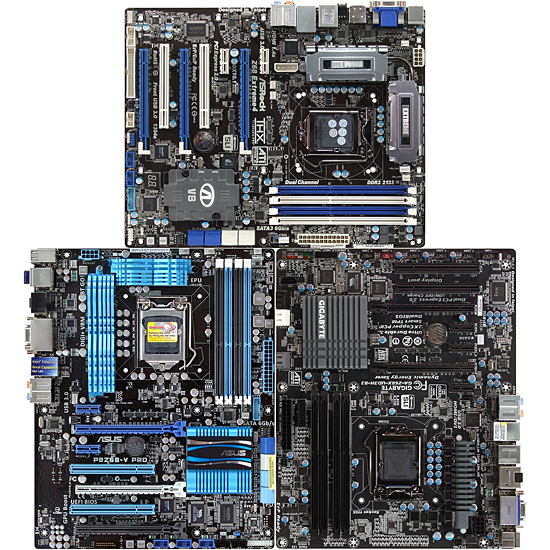Z68 Express Roundup: Three Motherboards Do Battle Around $200
Intel reserved its most feature-rich LGA 1155 platform for (or four?) months past the launch of its Sandy Bridge-based processors, but was it worth the wait? We compare three upper-mainstream Z68 examples to a top-quality P67 predecessor to find out.
Overclocking, Quick Sync, And SSD Caching
We were initially stoked by how much better Intel’s current-generation processors are than their predecessors, combining quantifiable per-clock performance gains with lower power consumption, higher clock speeds, and vastly superior overclocking capability.
And yet, perhaps the most significant addition to the company's second-gen Core processors, Quick Sync-accelerated video transcoding, was limited to very inflexible H67 Express-based platforms. The P67 chipset allowed us to taste the new processor’s awesome overclocking, while its inability to access the architecture's integrated graphics core left a bad taste in our mouth.

Intel changes all of that with the release of Z68 Express, the uninhibited chipset that now sits atop Intel's mainstream-performance lineup. Now we even have the motherboards to prove it.
If you aren't yet familiar with the new platform, check out our coverage of the chipset itself in The Intel Z68 Express Review: A Real Enthusiast Chipset.
| P67 Motherboard Features | |||
|---|---|---|---|
| Row 0 - Cell 0 | ASRock Z68 Extreme4 | Asus P8Z68-V Pro | Gigabyte Z68X-UD3H-B3 |
| PCB Revision | 1.01 | 1.01 | 0.2 |
| Chipset | Intel Z68 Express | Intel Z68 Express | Intel Z68 Express |
| Voltage Regulator | 12 Phases | 16 Phases | Seven Phases |
| BIOS | P1.10 (04/22/2011) | 8801 Beta (04/28/2011) | F2e (04/28/2011) |
| 100.0 MHz BCLK | 99.8 (-0.2%) | 100.3 (+0.03%) | 100.3 (+0.03%) |
| Clock Generator | Z68 Integrated | Z68 Integrated | Z68 Integrated |
| Internal Interfaces | |||
| PCIe x16 | 3 (x16/x0/x4 or x8/x8/x4) | 3 (x16/x0/x4 or x8/x8/x4) | 2 (x16/x0 or x8/x8) |
| PCIe x1/x4 | 2/0 | 2/0 | 2/0 |
| Legacy PCI | 2 | 2 | 2 |
| USB 2.0 | 3 (6-ports) | 3 (6-ports) | 4 (8-ports) |
| USB 3.0 | 1 (2-ports) | 1 (2-ports) | 1 (2-ports) |
| IEEE-1394 | 1 | 2 | 1 |
| Serial Port | 1 | None | 1 |
| Parallel Port | None | None | None |
| Floppy | Yes | No | No |
| Ultra-ATA 133 | None | None | None |
| SATA 3.0Gb/s | 4 | 4 | 3 |
| SATA 6.0Gb/s | 4 | 4 | 4 |
| 4-Pin Fan | 2 | 3 | 2 |
| 3-Pin Fan | 4 | 3 | 2 |
| FP-Audio | Yes | Yes | Yes |
| CD-Audio | No | No | No |
| S/PDIF I/O | Output Only | Output Only | Output Only |
| Power Button | Yes | Yes | No |
| Reset Button | Yes | Yes | No |
| CLR_CMOS Button | Jumper Only | Jumper Only | Jumper Only |
| Diagnostics Panel | Numeric | Pass/Fail LEDs | Pass/Fail LEDs |
| I/O Panel Connectors | |||
| P/S 2 | 2 | None | 1 |
| USB 2.0 | 4 | 6 | 4 |
| USB 3.0 | 2 | 2 | 2 |
| IEEE-1394 | 1 | None | 1 |
| Network | Single | Single | Single |
| eSATA | 1 | 1 | 1 |
| CLR_CMOS Button | Yes | No | No |
| Digital Audio Out | Optical Only | Optical Only | Optical Only |
| Digital Audio In | None | None | None |
| Analog Audio | 5 | 6 | 6 |
| Video Out | 1 Each: DVI, HDMI, VGA, DisplayPort | 1 Each: DVI, HDMI VGA | 1 Each: DVI, HDMI, VGA, DisplayPort |
| Other Devices | None | Bluetooth Transceiver | None |
| Mass Storage Controllers | |||
| Chipset SATA | 2 x SATA 6Gb/s 4 x SATA 3Gb/s | 2 x SATA 6Gb/s 4 x SATA 3Gb/s | 2 x SATA 6Gb/s 4 x SATA 3Gb/s |
| Chipset RAID Modes | 0, 1, 5, 10 | 0, 1, 5, 10 | 0, 1, 5, 10 |
| Add-In SATA | Marvell 9120 PCIe2 x SATA 6Gb/s 1 x eSATA (shared) | Marvell 9172 PCIe2 x SATA 6Gb/s 2 x eSATA 3Gb/s | Marvell 9172 PCIe |
| Add-In Ultra ATA | None | None | None |
| USB 3.0 | 2 x Etron EJ168A PCIe | 2 x ASM1042 PCIe | 2x Etron EJ168A PCIe |
| IEEE-1394 | VT6315N PCIe 2 x 400 Mb/s | VT6308P PCI 2 x 400 Mb/s | VT6308P PCI 2 x 400 Mb/s |
| Gigabit Ethernet | |||
| Primary LAN | Broadcom BCM57781 PCIe | WG82579V PHY | RTL8111E PCIe |
| Secondary LAN | None | None | None |
| HD Audio | |||
| HD Audio Codec | ALC892 | ALC892 | ALC889 |
| DDL/DTS Connect | None | None | None |
Stay On the Cutting Edge: Get the Tom's Hardware Newsletter
Get Tom's Hardware's best news and in-depth reviews, straight to your inbox.
Current page: Overclocking, Quick Sync, And SSD Caching
Next Page ASRock Z68 Extreme4-
Crashman user 18ASrock comes with 4 eSATA cables?KisakukuThe first UEFI screenshots for ASRock and Asus are switched.Fixed, thanks!Reply -
evga_fan ->ThomasReply
"Gigabyte’s Quick Boost application sets our processor at 200, 400, or 700 MHz beyond its rated frequency."
Just so you know. Anyways, keep up the good work!
Cheers -
crisan_tiberiu so, basicaly there is no difference in performance between theese boards as i can see.Reply -
hmm .. was thinking of getting an Asus P8Z68-V Pro .. not so sure now knowing that the other boards offer the same performance and are both cheaper.Reply
-
Olle P One additional feature of the ASRock card that isn't mentioned is its set of holes matching a socket 775 cooler. That feature was the main reason I ordered one of these cards three days ago, since I won't have to spend money on a new CPU cooler.Reply -
crisan_tiberiu Olle POne additional feature of the ASRock card that isn't mentioned is its set of holes matching a socket 775 cooler. That feature was the main reason I ordered one of these cards three days ago, since I won't have to spend money on a new CPU cooler.Reply
ermm thats pro, since i have a socket 775 core 2 duo atm. Any other motherboards out there that suport this?? i would love to know
